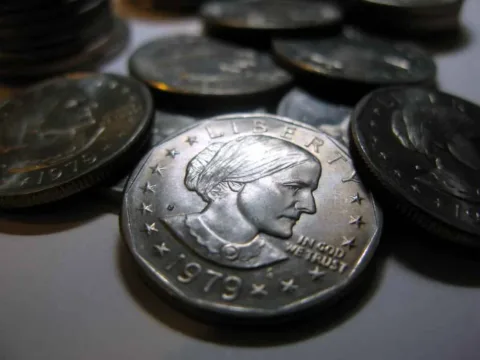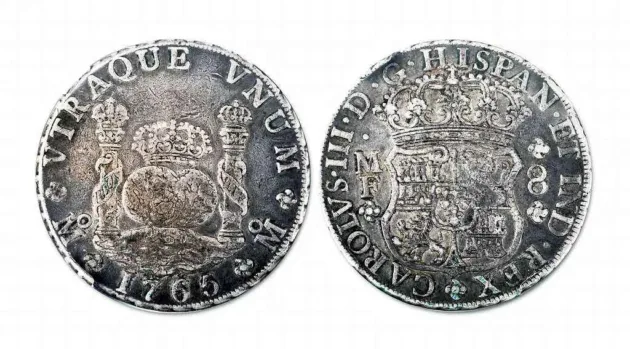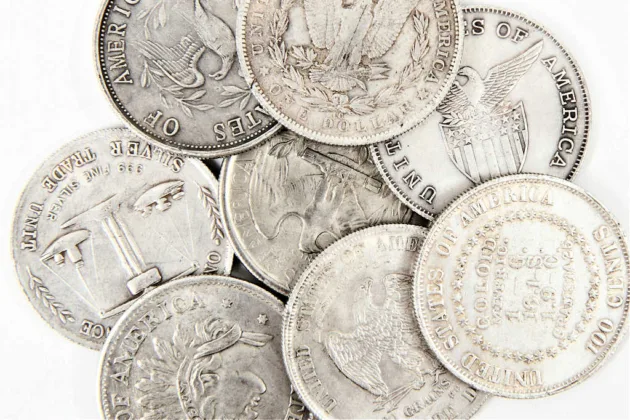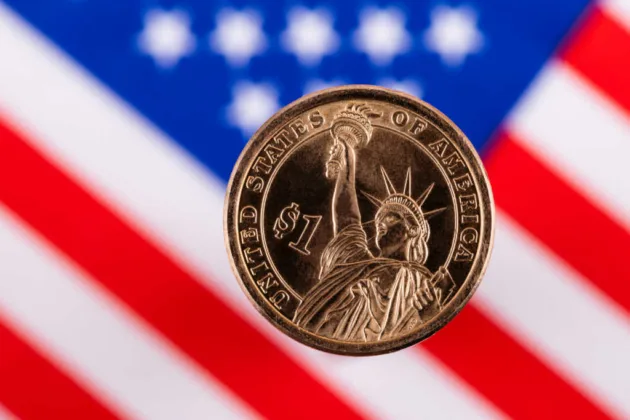
We don’t see many dollar coins in circulation these days…
It’s been a long, Long, LONG time since Americans were using dollar coins on a frequent basis — much less silver dollars!
Going back through the history of the dollar coin in the United States, the very first official silver dollars were struck for circulation way back in 1794 — just two years after the United States Mint was established in 1792.
The Origin Story Of The First U.S. Dollar Coin
If we want to go way back, then we must look to a time before the United States had a dollar coin…
Before the U.S. dollar coin was legislated with the U.S. Coinage Act of 1792 (the same law that enacted the establishment of the United States Mint), there was the Spanish milled dollar.

Popularly known as the 8 real, peso, or “pieces of eight,” the Spanish milled dollar was minted by the Spanish Empire beginning in 1497 — with mints in Mexico and elsewhere in Latin America producing this coin by the 16th century. In 1704, Queen Anne of Great Britain made the Spanish milled dollar a unit of legal-tender currency in the American colonies with an equivalent value of 6 shillings.
As early as the 1580s, the coin was known as a “dollar” — and by the time the United States had formed into a nation and was looking to produce its own sovereign currency, the Spanish milled dollar was deeply entrenched in American commerce. So much so that it was the model for the U.S. silver dollar that was legislated as part of the Coinage Act of 1792.
The law regarding the production of silver dollars said they were “to be of the value of a Spanish milled dollar as the same is now current, and to contain three hundred and seventy-one grains and four sixteenth parts of a grain of pure, or four hundred and sixteen grains of standard silver.”
And, with the passage of the Coinage Act of 1792, the first U.S. silver dollar coin was born!
But the first U.S. silver dollars wouldn’t be struck until two years later, in 1794…
A List Of All U.S. Dollar Coins
The United States dollar coin became a fixture in the American monetary system — with many different kinds struck since 1794. Some you may have heard of, while others are extremely rare and little known by the public except for within the community of coin collectors and those involved in antiques.

These are all of the different types of dollar coins struck by the United States Mint:
Flowing Hair Silver Dollars (1794-1795)
The first silver dollar ever made by the United States Mint was the Flowing Hair dollar, featuring a portrait of Miss Liberty with long locks on the obverse (“heads side”) and an eagle encircled within a wreath on the reverse (“tails side”). This design was in use for only two years but is historically significant.
The 1794 and 1795 dollars are also very valuable, with prices ranging from a minimum of around $3,500. The most valuable example ever sold was a special specimen striking of the 1794 dollar with a silver plug that many historians believe was the very first individual silver dollar ever struck by the United States Mint. The coin, graded Specimen-66 by Professional Coin Grading Service, commanded $10,016,875 in a 2013 auction.
Draped Bust Dollars (1795-1804)
The Draped Bust dollar became the second type of dollar coin struck by the United States Mint. Draped Bust dollars were minted for nearly a decade, and over that time the coin carried two reverse designs — the first one was a carryover of the eagle inside the wreath as seen on the Flowing Hair dollar, which in 1798 was changed to a portrait of a much larger heraldic eagle.
Draped Bust dollars are very popular with coin collectors. These coins sell in the range of $1,500 to $5,000 for typical specimens, though some are much more expensive than that. The most famous of all Draped Bust dollars is dated 1804 and was struck as a proof coin in the mid-1830s and given in proof sets as a diplomatic gift to foreign heads of state. The most valuable 1804 Draped Bust dollar was graded Proof-68 by Professional Coin Grading Service and sold for $7,680,000 in 2021.
Liberty Seated Dollars (1836-1873)
After silver dollar production took a hiatus after 1804, the United States Mint resumed making dollar coins in the mid-1836, by way of a limited run of a dollar coin featuring a motif of a seated Miss Liberty on the obverse and a flying eagle on the reverse as designed by Christian Gobrecht. In 1840, production was significantly expanded, and the flying eagle design revamped with a left-facing eagle.
Some suggest the Liberty Seated dollars of 1836 through 1839, usually referred to as “Gobrecht dollars,” are patterns. But all issues are highly collectible and usually sell for $300 to $500 and up. One of the most valuable Liberty Seated dollars sold was a Brilliant Uncirculated 1870-S dollar that took $1,092,500 in 2003.
Trade Dollars (1873-1885)
As the United States was expanding its global trade ambitions, the nation wanted to create a silver coin that would compete on the international scene against other popular silver trade coins of the day. Thus, the Trade dollar was born in 1873. The coin, which was not intended to be used in large quantities for domestic circulation, was exported mostly to Asia, where the coin heavily circulated.
Production of the Trade dollar was scaled back by the late 1870s, with only proofs being made for collectors during the remainder of the coin’s run. Today, circulated specimens of the Trade dollar fetch between $250 and $500 or more. The most valuable Trade dollar was an 1885 proof graded Proof-66 by Numismatic Guaranty Company that garnered $3,960,000 in a 2019 sale.
Morgan Dollars (1878-1921)
There’s probably no silver dollar that’s more popular or widely collected than the Morgan dollar. The quintessential coin of the Old West, the Morgan dollar had its heyday during the nation’s pioneer days of westward expansion into the silver-rich reaches of the Rockies and the West Coast. The coin, with its portrait of Miss Liberty on the obverse and a heraldic eagle on the reverse, was designed by George T. Morgan, for whom the “Liberty Head” dollar is informally named by coin collectors.
Many collectors attempt to build entire sets of the Morgan dollar from beginning to end, an expensive endeavor that can take decades and many thousands of dollars. The most common dates can be had for less than $50 or $100, but the rarest key dates, such as the 1889-CC, 1893-S, and 1895 proof each cost several thousand dollars, even in circulated condition. Of these, the 1889-CC has proven among the most valuable, with one example in Mint State-68 selling for $881,250 in 2013. Meanwhile, the 1921 Morgan silver dollars are valuable and among the most commonly encountered coins from this series.
Peace Dollars (1921-1935)
The Peace dollar introduced the world to the face of a young, ray-emitting Miss Liberty paired with an eagle standing on a rock — symbolic of peace in a world that was emerging from what then known as “The Great War” (World War I). Peace dollars are widely collected, though the series didn’t last as long as its predecessor, the Morgan dollar.
The most common Peace dollars are dated 1922, 1923, 1924, and 1925, and they generally sell for less than $50 to $100 apiece. The most valuable Peace dollars include the 1921, 1928, and 1934-S, with one particularly high-grade 1921 silver dollar fetching $132,000 in a 2018 auction.
Eisenhower Dollars (1971-1978)
After a production hiatus of more than three decades, the silver dollar resumed its run in 1971 with the introduction of the Eisenhower dollar. The Ike dollar, referencing 34th President Dwight Eisenhower’s popular nickname, became the last large-size circulating dollar coin. However, the Eisenhower dollar didn’t circulate much at all. By the 1970s, most Americans had a preference for the folding, lightweight dollar bill.
The Eisenhower dollar saw a highwater mark with the production of the 1776-1976 Bicentennial dollar, which is still a beloved collector coin that can be had for less than $5 to $10. Other clad Eisenhower dollars go for similar prices, while the 40% silver uncirculated and proof offerings, which bear an “S” mintmark from the San Francisco Mint, go for higher prices.
Susan B. Anthony Dollars (1979-1999)
The Eisenhower dollar was replaced by the Susan B. Anthony dollar in 1979. Known as the mini-dollar due to its smaller size (just barely bigger than a modern-day quarter), the Susan B. Anthony dollar became the first widely circulating U.S. coin to feature an historical woman. However, the coin was too easily confused with the quarter due to their similar size and color, and by 1981 the coin was retired. The coin resumed production in 1999 to fill demands for dollar coinage.
More recently, the Susan B. Anthony dollar has gained more attention as a collectible coin. However, most examples are still pretty inexpensive and can be had for a few dollars apiece. The priciest are the 1979-P Wide Rim variety, which retails for between $25 and $50, and the 1979-S Type II and 1981-S Type II proofs, which go for around $50 and $100 apiece, respectively.
Sacagawea Dollars (2000-Present)
The Sacagawea dollar debuted in 2000, carrying on its obverse a portrait of Sacagawea, an indigenous woman who became famous for guiding explorers Meriwether Lewis and William Clark across land acquired in the Louisiana Purchase. Sacagawea’s infant son, Jean Baptiste Charbonneau, is the baby in the papoose. On the reverse is a soaring eagle.
Despite its distinctive golden color, the Sacagawea dollar failed to gain traction as a circulating coin. In 2009, the Sacagawea dollar was transformed into the canvas for the Native American Dollar program, which retains the Sacagawea motif on the obverse and on the reverse features a new design each year honoring Native American individuals, achievements, or culture. Most issues are presently obtainable for small premiums above face value.
Presidential Dollars (2007-2016)
The Presidential $1 Coin program launched in 2007 to honor all former, deceased United States presidents in the order they served in office, beginning with President George Washington. The series continued at a clip of four coins a year until 2016, when only three coins were necessary to round out the program. Since then, President George Bush passed away, and he was subsequently honored in 2020.
Along with the president, each First Spouse was also honored in concert to when their Commander-in-Chief mate was placed on coins. In cases when there was no First Spouse to completement a president during their terms, a coin design contemporary to the president’s term(s) was used on the First Spouse coin instead. Presidential $1 Coins sell for nominal premiums above face value, but errors such as the infamous Godless Dollars can sell for more than $100.
American Innovation Dollars (2018-2032)
American Innovation Dollar series began a run in 2018 and runs through 2032 honoring innovations and innovators from each of the 50 states, the District of Columbia, and the U.S. territories. The series unveils four new coins each year. While the coins have generally not been distributed into circulation, they are legal tender and can be spent as money.
The American Innovation Dollars are easily obtainable through the U.S. Mint and coin dealers, and they are not usually priced a whole lot over face value. This makes them a breeze to collect and highly affordable for many collectors who wish to assemble a set of these popular dollar coins.
Let’s Not Forget The Gold Dollar!
No discussion of the American dollar coin is complete without at least a quick acknowledgement of the United States gold dollar.

Struck from 1849 through 1889, this tiny gold coin was denominated at $1 and did a lot of heavy lifting in circulation — especially in the West during its frontier heyday.
Gold dollar coins are very valuable, most selling for more than $250 to $300.
There are 3 basic types, all profiling a head of Miss Liberty on the obverse — with two of these portraits showing Liberty wearing a Native American headdress. The reverses of the 3 coins showcase a wreath bearing the inscription “1 DOLLAR” and the coin’s date.
I’m the Coin Editor here at TheFunTimesGuide. My love for coins began when I was 11 years old. I primarily collect and study U.S. coins produced during the 20th century. I’m a member of the American Numismatic Association (ANA) and the Numismatic Literary Guild (NLG) and have won multiple awards from the NLG for my work as a coin journalist. I’m also the editor at the Florida United Numismatists Club (FUN Topics magazine), and author of Images of America: The United States Mint in Philadelphia (a book that explores the colorful history of the Philadelphia Mint). I’ve contributed hundreds of articles for various coin publications including COINage, The Numismatist, Numismatic News, Coin Dealer Newsletter, Coin Values, and CoinWeek. I’ve authored nearly 1,000 articles here at The Fun Times Guide to Coins (many of them with over 50K shares), and I welcome your coin questions in the comments below!

